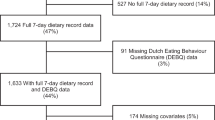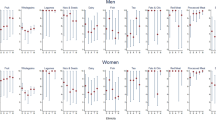Abstract
Background/objectives:
Daily practices related to eating are embedded in the social and cultural contexts of everyday life. How are such factors associated with diet quality relative to motivational factors? And, are associations universal or context-specific? We analyze the relationship between diet quality and the following practices: social company while eating, the regularity and duration of eating and the activity of watching TV while eating.
Subjects/methods:
A cross-sectional, questionnaire-based internet survey was conducted in April 2012 with stratified random samples of the populations (aged 15–80 years) in Denmark, Finland, Norway and Sweden (N=7531, completion rate 9–13%). The questionnaire elicited detailed accounts of one day of eating focusing on social and practical aspects of eating events. The validated Dietary Quality Score was the dependent variable. This measure is based on eight food frequency questions focusing on fats, vegetables, fruits and fish in the diet.
Results:
Eating activities were associated with diet quality even when motivation to eat healthily and sociodemographic factors were controlled for. The number of daily eating events and eating main meals was positively correlated with diet quality in all countries. Beyond that, activities that were significantly associated with diet quality varied with country. When measured separately, the association between each activity and diet quality was weaker than motivation to eat healthily, but in combinations that are found in parts of the populations, the association was substantial.
Conclusions:
Daily practices related to eating are correlated with diet quality. Practices that are important are in part universal but also country-specific. Efforts to promote healthy eating should address not only cognitive factors but also everyday contexts of eating that facilitate or hamper healthy practices.
This is a preview of subscription content, access via your institution
Access options
Subscribe to this journal
Receive 12 print issues and online access
$259.00 per year
only $21.58 per issue
Buy this article
- Purchase on Springer Link
- Instant access to full article PDF
Prices may be subject to local taxes which are calculated during checkout
Similar content being viewed by others
References
Bandura A . Health promotion by social cognitive means. Health Educ Behav 2004; 31: 143–164.
Brug J . Determinants of healthy eating: motivation, abilities and environmental opportunities. Family Pract 2008; 25: i50–i55.
Connor M, Norman P, Bell R . The theory of planned behavior and healthy eating. Health Psychol 2002; 21: 194–201.
Sheeshka JD, Woolcott DM, Mackinnon NJ . Social cognitive theory as a framework to explain intentions to practice healthy eating behaviors. J Appl Soc Psychol 1993; 23: 1547–1573.
Backman DR, Haddad EH, Lee JW, Johnston PK, Hodkin GE . Psychosocial predictors of healthful dietary behavior in adolescents. J Nutr Educ Behav 2002; 184–193.
Gronow J, Warde A . Introduction. In: Gronow J, Warde A (eds). Ordinary Consumption. Routledge: London, UK and New York, NY, USA, pp 1–8, 2001.
Connors M, Bisogni CA, Sobal J, Devine CM . Managing values in personal food systems. Appetite 2001; 36: 189–200.
Halkier B, Katz-Gerro T, Martens L . Applying practice theory to the study of consumption: theoretical and methodological considerations. J Consum Cult 2011; 11: 3–13.
Riet Jv, Sijtsema SJ, Dagevos H, De Bruijn GJ . The importance of habits in eating behaviour. An overview and recommendations for future research. Appetite 2011; 57: 585–596.
van Woerkum C, Bouwman L . 'Getting things done': an everyday-life perspective towards bridging the gap between intentions and practices in health-related behavior. Health Promot Int 2014; 29: 278–286.
Fischler C . Commensality, society and culture. Soc Sci Inform 2011; 50: 528–548.
Rotenberg R . The impact of industrialization on meal patterns in Vienna, Austria. Ecol Food Nutr 1981; 11: 25–35.
Southerton D . Habits, routines and temporalities of consumption: from individual behaviours to the reproduction of everyday practices. Time & Society 2013; 22: 335–355.
Herman CP, Roth DA, Polivy J . Effects of the presence of others on food intake: a normative interpretation. Psychol Bull 2003; 129: 873–886.
Sobal J . Sociability and meals: facilitation, commensality, and interaction. In: Meiselman HL (ed). Dimensions of the Meal. The Science, Culture, Business, and Art of Eating. Aspen Publishers Inc.: Gaithersburg, MD, USA, pp 119–133, 2000.
de Castro JM, de Castro ES . Spontaneous meal patterns of humans: influence of the presence of other people. Am J Clin Nutr 1989; 50: 237–247.
de Castro JM, Brewer EM, Elmore DK, Orozco S . Social facilitation of the spontaneous meal size of humans occurs regardless of time, place, alchol or snacks. Appetite 1990; 15: 89–101.
Bell R, Pliner PL . Time to eat: the relationship between the number of people eating and meal duration in three lunch settings. Appetite 2003; 41: 215–218.
Feunekes GIJ, de Graaf C, van Staveren WA . Social facilitation of food intake is mediated by meal duration. Physiol Behav 1995; 58: 551–558.
Redd M, de Castro JM . Social facilitation of eating: effects of social instruction on food intake. Physiol Behav 1992; 52: 749–754.
Pliner P, Bell R . A table for one: the pain and pleasure of eating alone. In: Meiselman H (ed). Meals in Science and Practice. Woodhead Publishing Limited: Oxford, UK, pp 169–189, 2009.
Donkin AJM, Johnson AE, Lilley JM, Morgan K, Neale RJ, Page RM et al. Gender and living alone as determinants of fruit and vegetable consumption among the elderly living at home in urban Nottingham. Appetite 1998; 30: 39–51.
Kerver JM, Yang EJ, Obayashi S, Bianchi L, Song WO . Meal and snack patterns are associated with dietary intake of energy and nutrients in US adults. J Am Diet Assoc 2006; 106: 46–53.
Holmbäck I, Ericson U, Gullberg B, Wirfält E . A high eating frequency is associated with an overall healthy lifestyle in middle-aged men and women and reduced likelihood of general and central obesity in men. Br J Nutr 2010; 104: 1065–1073.
Pedersen TP, Meilstrup C, Holstein BE, Rasmussen NK . Fruit and vegetable intake is associated with frequency of breakfast, lunch and evening meal: cross-ssectional study of 11- 13-, and 15-year-olds. Int J Behav Nutr Phys Act 2012; 9: 9.
Lazzeri G, Pammolli A, Azzolini E, Simi R, Meoni V, de Wet DR et al. Association between fruits and vegetables intake and frequency of breakfast and snacks consumption: a cross-sectional study. Nutr J 2013; 12: 123.
Sjöberg A, Hallberg L, Höglund D, Hulthén L . Meal pattern, food choice, nutrient intake and lifestyle factors in The Göteborg Adolescence Study. Eur J Clin Nutr 2003; 57: 1569–1578.
Affenito SG, Thompson DR, Barton BA, Franko DL, Daniels SR, Obarzanek E et al. Breakfast consumption by African-American and white adolescent girls correlates positively with calcium and fiber intake and negatively with body mass index. J Am Diet Assoc 2005; 105: 938–945.
Storey KE, Hanning RM, Lambraki IA, Driezen P, Fraser SN, McCargar LJ . Determinants of diet quality among canadian adolescents. Canad J Diet Pract Res 2009; 70: 58–65.
Chaplin KS, Smith AP . Snacking frequency, mental health, health beliefs and physical health. Curr Top Nutraceut Res 2011; 9: 41–45.
Ovaskainen ML, Reinivuo H, Tapanainen H, Hannila ML, Korhonen T, Pakkala H . Snacks as an element of energy intake and food consumption. Eur J Clin Nutr 2006; 60: 494–501.
Ovaskainen ML, Tapanainen H, Pakkala H . Changes in the contribution of snacks to the daily energy intake of Finnish adults. Appetite 2010; 54: 623–626.
Whybrow S, Kirk TR . Nutrient intakes and snacking frequency in female students. J Hum Nutr Diet 1997; 10: 237–244.
Zizza CA, Xu BB . Snacking is associated with overall diet quality among adults. J Acad Nutr Diet 2012; 112: 291–296.
Sisson SB, Shay CM, Broyles ST, Leyva M . Television-viewing time and dietary quality among U.S. children and adults. Am J Prev Med 2012; 43: 196–200.
Feldman S, Eisenberg ME, Neumark-Sztainer D, Story M . Associations between watching TV during family meals and dietary intake among adolescents. J Nutr Behav 2007; 39: 257–263.
Granner ML, Mburia-Mwalili A . Correlates of television viewing among African American and Caucasian women. Women Health 2010; 50: 783–794.
Blass EM, Anderson DR, Kirkorian HL, Pempek TA, Price I, Koleini MF . On the road to obesity: television viewing increases intake of high-density foods. Physiol Behav 2006; 88: 597–604.
Fuglestad PT, Jeffery RW, Sherwood NE . Lifestyle patterns associated with diet, physical activity, body mass index and amount of recent weight loss in a sample of successful weight losers. Int J Behav Nutr Phys Act 2012; 9: 79.
Liang T, Kuhle S, Veugelers PJ . Nutrition and body weights of Canadian children watching televison and eating while watching television. Public Health Nutr 2009; 12: 2457–2463.
Holm L . The social context of eating. In: Kjærnes U (ed). Eating Patterns A Day in the Lives of Nordic Peoples. Sifo: Oslo, Norway, pp 159–198, 2001.
Kjærnes U (ed) Eating Patterns: A Day in the Lives of Nordic Peoples. Oslo, Norway: Sifo, 2001.
Holm L, Ekström MP, Gronow J, Kjærnes U, Lund TB, Mäkelä J et al. The modernization of Nordic eating: studying changes and stabilities in eating patterns. Anthropol Food (Online) 2012; S7.
Callegaro M, Disogra C . Computing response metrics for online panels. Public Opinion Quarterly 2008; 72: 1008–1032.
Holbrook AL, Krosnick JA, Pfent A et al. The causes and consequences of response rates in surveys by the news media and government contractor surveys research firms. In: Lepkowski JM, Tucker C, Brick M, de Leeuw E, Japec L, Lavrakas PJ, (eds). Advances in Telephone Survey Methodology. Wiley: New York, NY, USA, pp 499–678, 2008.
Kohut A, Keeter S, Dimock CD, Dimock M, Christian L . Assessing the Representativeness of Public Opinion Surveys. Peoples Press: Washington, DC, USA, 2012.
Lund TB, Gronow J . Destructuration or continuity? The daily rhythm of eating in Denmark, Finland, Norway and Sweden in 1997 and 2012. Appetite 2014; 82: 143–153.
Toft U, Kristoffersen LH, Lau C, Borch-Johnsen K, Jorgensen T . The Dietary Quality Score: validation and association with cardiovascular risk factors: the Inter99 study. Eur J Clin Nutr 2007; 61: 270–278.
Rose D, Harrison E . The European socio-economic classification: A new social class schemata for comparative European research. European Societies 2007; 9: 459–490.
Nicklas TA, O-Neil CE, Fulgoni VL III . Snacking patterns, diet quality, and cardiovascular risk facdtors in adults. BMC Public Health 2014; 14: 388.
Acknowledgements
The study was supported financially by the Joint Committee for Nordic Research Councils for the Humanities and Social Sciences (NOS-HS). The study design was devised by the authors and project partners: Marianne Pipping Ekström, University of Gothenburg; Jukka Gronow, University of Helsinki; Unni Kjærnes, National Institute for Consumer Research, Oslo; Johanna Mäkelä, University of Helsinki.
Author information
Authors and Affiliations
Corresponding author
Ethics declarations
Competing interests
The authors declare no conflict of interest.
Rights and permissions
About this article
Cite this article
Holm, L., Lund, T. & Niva, M. Eating practices and diet quality: a population study of four Nordic countries. Eur J Clin Nutr 69, 791–798 (2015). https://doi.org/10.1038/ejcn.2015.61
Received:
Revised:
Accepted:
Published:
Issue Date:
DOI: https://doi.org/10.1038/ejcn.2015.61
This article is cited by
-
Comparison of Meal Patterns Across Common Racial Groups in the UK and the USA, Examining Associations with Weight Status and Diet Quality: a Secondary Analysis of NDNS and NHANES Datasets
Journal of Racial and Ethnic Health Disparities (2023)
-
Identifying eating habits in Finnish children: a cross-sectional study
BMC Public Health (2019)
-
The Diet-related GHG Index: construction and validation of a brief questionnaire-based index
Climatic Change (2017)
-
Associations between company at dinner and daily diet quality in Dutch men and women from the NQplus study
European Journal of Clinical Nutrition (2016)
-
The Prevalence and Risk of Food Insecurity in the Nordic Region: Preliminary Results
Journal of Consumer Policy (2016)



